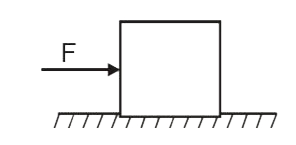A block of mass is initially at rest on a rough horizontal surface. A force of acts over a distance of . The force of friction acting on the block is . The final kinetic energy of the block is
The correct Answer is:
Topper's Solved these Questions
- BOOK - NARAYNACHAPTER - WORK , ENERGY & POWER EXERCISE - EXERCISE -III54videos
WORK , ENERGY & POWER
- BOOK - NARAYNACHAPTER - WORK , ENERGY & POWER EXERCISE - EXERCISE IV43videos
WORK , ENERGY & POWER
- BOOK - NARAYNACHAPTER - WORK , ENERGY & POWER EXERCISE - EXERCISE -II (C.W)75videos
WORK , ENERGY & POWER
- BOOK - NARAYNACHAPTER - WAVESEXERCISE - Exercise-IV56videos
WAVES
- BOOK - NARAYNACHAPTER - WORK POWER AND ENERGYEXERCISE - Level-VI (Integer)12videos
WORK POWER AND ENERGY
Similar Questions
A block of mass 1 kg in kept on a rough horizontal surface with μs=0.1 . A force of 0.5 N is applied as shown in the figure. What is the frictional force applied by ground on the block?
 View Solution
View SolutionA block of mass 5kg is resting on a rough surface as shown in the figure. It is acted upon by a force of F towards right. Find frictional force acting on block when 25N.
 View Solution
View Solution
Knowledge Check
- Question 1 - Select One
A block of mass 4kg is initially at rest on a horizontal frixtionless surface. A horizontal force →F=(3+x)ˆi newtons acts on it, when the block is at x=0. The maximum kinetic energy of the block between x=0 and x=2m is
A6JB8JC9JD10J - Question 2 - Select One or More
A block of mass 2 kg, initially at rest on a horizontal floor, is now acted upon by a horizontal force of 10N. The coefficient of friction between the block and the floor is 0.2. If g=10m/s2, then :
AThe work done by the applied force in 4 s is 240 J.BThe work done by the firctional force in 4s is 0,CThe work done by the net forces in 4s is 0.sDThe change in kinetic energy of the block in 4s is 144 J. - Question 3 - Select One
A block of mass m is placed on a rough horizontal surface. If minimum force to pull the block is mg2 then coefficient of friction is :
A12B√3C1√3DNone
A 2.5 kg block is initially at rest on a horizontal surface. A horizontal force →F of magnitude 6.0 N and a vertical force →P are then applied to the block (Fig. 6-31). The coefficients of friction for the block and surface are μ=0.40andμ=0.25. Determine the magnitude of the frictional force acting on the block if the magnitude of →P is (a) 8.0 N. (b) 10 N, and (c) 12 N
 View Solution
View SolutionA 20 kg block is initially at rest on a rough horizontal surface. A horizontal force of 75 N is required to set the block in motion. After it is in motion, a horizontal force of 60 N is required to keep the block moving with constant speed. The coefficient of static friction is
View SolutionA 10kg block is initially at rest on a rough horizontal surface. A horizontal force of 60N is required to set the block in motion . After it is in motion , a horizontal force of 50N is required to keep the block moving with constant velocity . The ratio coefficient of static and kinetic friction is
View SolutionA block of mass 4kg is initially at rest on a horizontal frictionless surface. A force →F=(2x+3x2)ˆiN acts horizontally on it. The maximum kinetic energy of the block between x=2m and x=4m in joules is
View SolutionA block of mass 4 kg is kept on a rough horizontal surface. The coefficient of static friction is 0.8. If a force of 19 N is applied on the block parallel to the floor, then the force of friction between the block and floor is
View Solution

